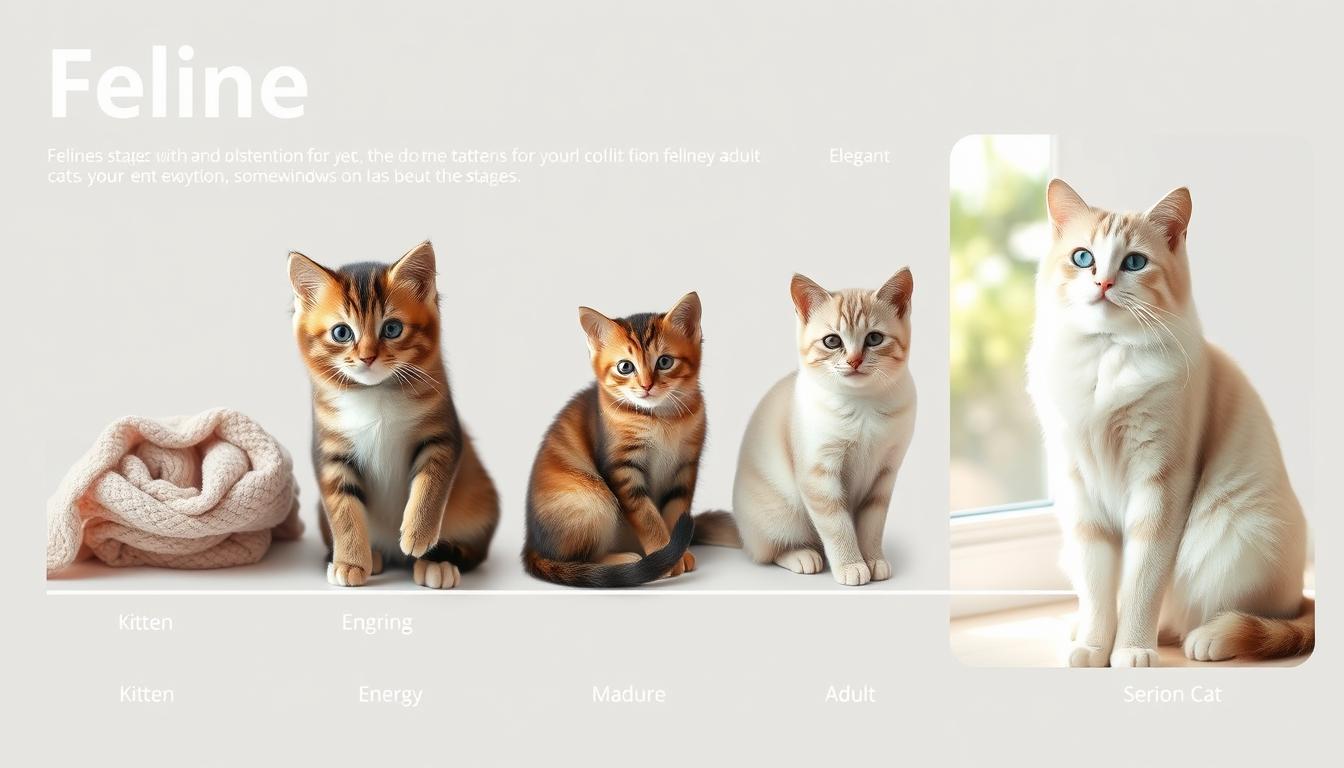Knowing when cats stop growing is key for cat owners. Most kittens are fully grown by 12 months. But, some breeds, like the Maine Coon can take 3 to 5 years. Growth varies by breed, genetics, and gender.
The average domestic cat weighs 6 to 12 pounds. Small to medium breeds usually reach 10 pounds by 12 months.
Understanding cat growth stages is important for care and nutrition. Cats can grow after six months, reaching full size in their first year. Breed, genetics, and gender affect when they stop growing.
Key Takeaways
- Cats typically reach full size between 12 months and 4 years old
- Some breeds, like the Maine Coon, grow faster than others
- Male cats tend to be heavier and grow at slightly slower rates than females
- Understanding the average cat’s growth timeline is crucial for proper care and nutrition
- Cat growth stages vary depending on breed, genetics, and gender
- When do cats stop growing? Most cats stop growing after 12 months, but some breeds take longer
- Knowing the cat growth stages helps owners identify potential health issues early on
Understanding the Basics of Feline Development
Feline development is a fascinating process. It shows how kittens grow into healthy adult cats. Knowing these stages helps pet owners make sure their cats are doing well. It also helps spot any health issues early.
The Importance of Growth Monitoring
It’s key to watch your cat’s growth for their health. Keeping an eye on a cat growth chart is important. It helps find any size or weight issues early, so vets can help quickly.
Key Growth Indicators
- Consistent weight gain aligned with kitten development milestones.
- Increase in size as per the cat growth chart.
- Behavioral changes indicate healthy development.
General Timeline Overview
Kittens grow fast, often doubling in size in the first week. By six months, they’re about 75% of their adult size. Most cats reach full size by one year. But bigger breeds like Maine Coons might keep growing until they’re three to four years old.
Knowing these growth patterns helps owners give the right food and care. This is important for their cat’s development.
Newborn to Two Weeks: The Neonatal Period
The neonatal period is a critical time for kittens. A rapid cat growth rate and significant kitten development milestones mark it. In these first two weeks, kittens undergo big physical and behavioral changes. These changes lay the groundwork for their future growth.
At birth, kittens weigh between 1.8 and 5.3 ounces. In the first week, they can double in size, reaching up to 8.8 ounces. Their growth keeps going, with kittens gaining about an ounce every three days.
- First Few Days: Kittens can’t stand, with closed eyes and folded ears. They need constant care and feeding every two hours.
- One Week Old: Eyes start opening, and kittens weigh between 5.3 and 8.8 ounces. Their ears unfold, and they become a bit more active.
- Two Weeks Old: Kittens start interacting more with their surroundings, begin kneading, and grow to 8.8 to 12.3 ounces. Though they can’t retract their claws, their movements get more coordinated.
Proper nutrition is key to supporting the quick cat growth rate. Kittens depend on their mother’s milk for essential nutrients. Caregivers should ensure that kittens are eating well and watch their weight to hit important milestones for their development.
Early Growth Stage: Two to Eight Weeks
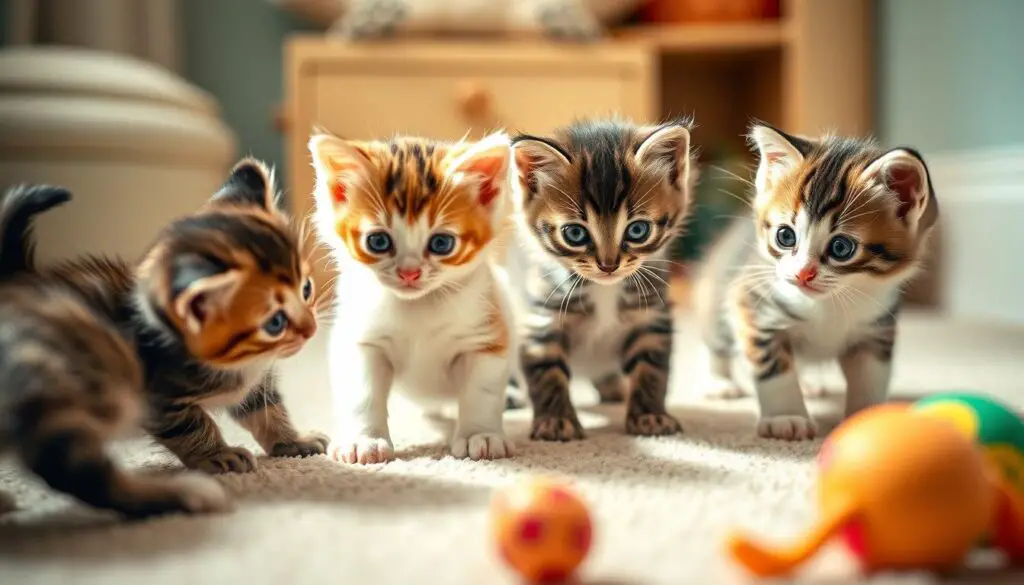
Kittens change a lot in their first eight weeks. These changes affect their health and behavior later on. Knowing these kitten development milestones helps them grow into healthy cats.
Physical Development Markers
- At two weeks, kittens start crawling, and their ear canals open, marking significant physical progress.
- By three weeks, they develop distinctive ear shapes and begin to explore their surroundings.
- At four weeks, kittens become more confident, try solid food, and improve their balance.
- From five to eight weeks, their eyes fully open, weight gain accelerates, and they become increasingly playful.
Behavioral Changes
Kittens become more curious and playful as their senses grow. Playing with their littermates helps them grow. It prepares them for life outside the litter.
Nutritional Needs During Early Growth
Good food is key during this time. Kittens move from nursing to solid foods. They need protein and nutrients for growth. Regular meals help track their progress.
When Do Cats Stop Growing? Understanding the Timeline
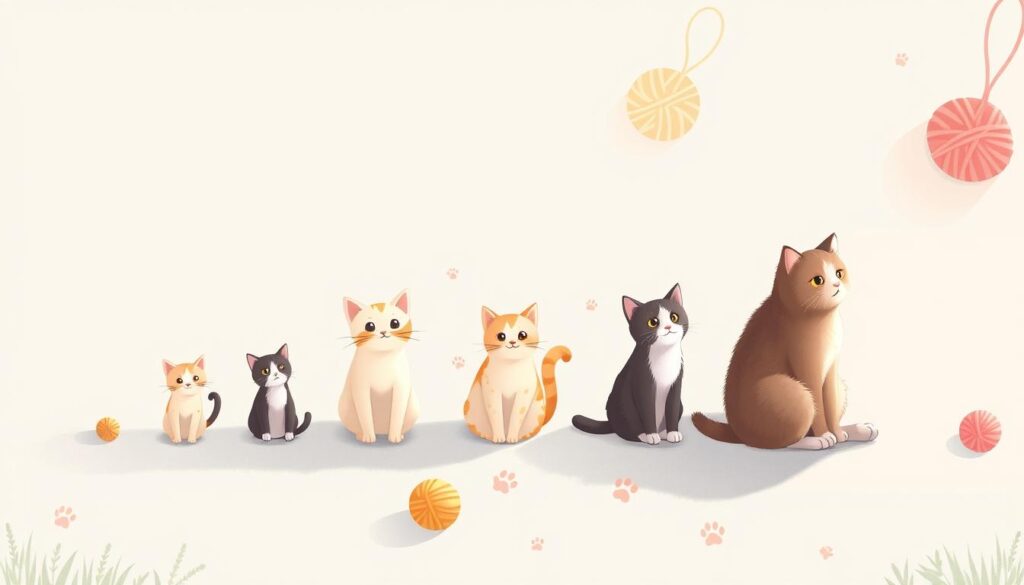
Cats usually become adults around 12 months old. At this time, their personalities are mostly set. But when exactly do cats stop growing? The average cat growth timeline reveals they can reach full size between 18 months and 4 years. This depends on several factors.
Many things affect when a cat stops growing, like breed, genetics, and if they’re spayed or neutered. For example, big breeds like Maine Coons might keep growing until they’re 2 to 4 years old. On the other hand, Siamese cats usually get to their full size by 12 to 16 months.
- Breed-specific growth patterns
- Genetic factors
- Early spaying or neutering
- Nutrition and overall health
Knowing the average cat growth timeline is key for pet owners. It helps them give the right care as their cat grows. Keeping an eye on their growth ensures they stay healthy and happy.
Factors Affecting Cat Growth and Development

Knowing the cat’s growth stages is key to helping your cat reach its best. Many things can affect how a cat grows and develops.
Breed-Specific Growth Patterns
Different breeds grow in their ways. Big breeds like Maine Coons and Ragdolls take about four years to grow up. On the other hand, smaller breeds like Singapura cats grow faster, finishing by nine months.
With their unique look, Savannah cats keep growing until they’re two years old.
Genetic Influences
Genetics are very important in a cat’s cat growth rate. What a cat inherits from its parents affects its size, build, and growth. For instance, genetic issues like pituitary dwarfism can slow growth. But good genetics can help a cat grow bigger.
Environmental Impact on Growth
The environment a cat grows up in matters a lot. Good food is essential; kittens need kitten food for the first year, then adult food at twelve months. How a kitten is cared for early on also affects its growth.
Cats from bigger litter might grow slower because they have to share food.
Physical and Mental Development Milestones

Knowing about kitten development milestones is key to your cat’s health. In the early cat growth stages, kittens change a lot. By four weeks, they weigh between 15.9 ounces and 1.2 pounds. They grow bigger each week.
Female cats usually reach their full size by 10–12 months. Male cats might grow until they are about 18 months old. This depends on breed and genetics. Spaying or neutering can also affect feline growth patterns, making them grow slower but healthier.
Kittens learn important social skills and behaviors in their first year. Early training and socialization are vital to avoid future problems. Playtime helps them physically and mentally, making them well-adjusted adults.
Keeping an eye on these milestones helps pet owners catch any issues early. Knowing about the different cat growth stages lets you support your cat at every life stage.
Nutrition’s Role in Healthy Cat Growth
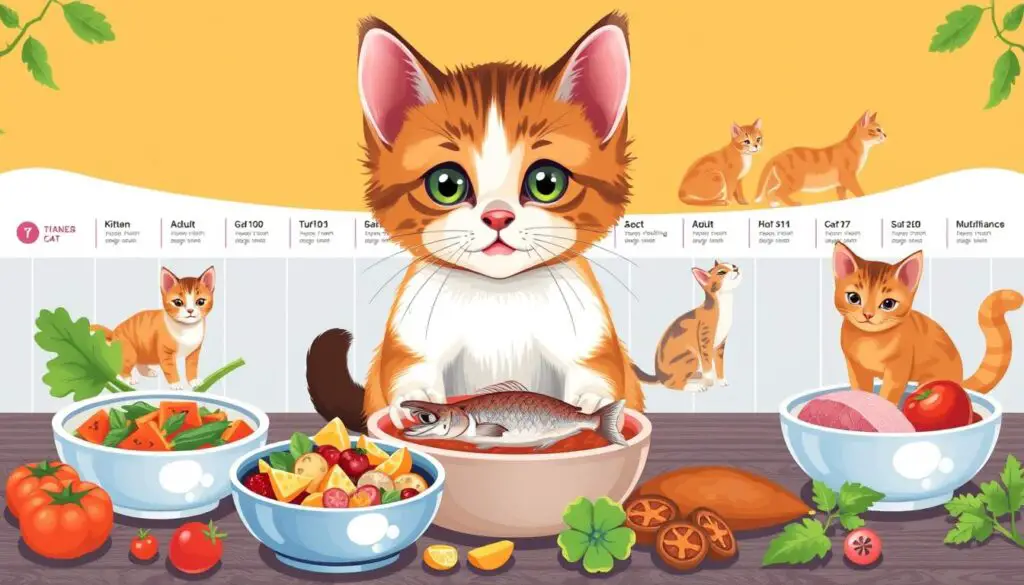
It’s crucial to feed your kitten right for their growth. A balanced diet helps them reach important milestones and grow well, as shown in the cat growth chart.
Essential Nutrients for Proper Development
Kittens need lots of protein and fat to grow fast. Look for a diet with 35-50% protein, at least 9% from animal sources. Fat should be 18-35% of their food, and calcium should be 0.8-1.6% on a dry matter basis.
Feeding Schedules by Age
Feeding should match kitten development milestones for steady growth:
- 0-8 weeks: Mother’s milk or kitten formula.
- 8-30 weeks: Start with high-protein kitten food, but watch the portions.
- 30 weeks-1 year: Switch to adult food as they grow bigger.
Most cats stop growing by one year. But bigger breeds, like Maine Coons, might take up to three years.
Signs of Nutritional Deficiencies
Watch for dull coat, tiredness, and slow growth. Regular weigh-ins and body checks help track their growth. This way, you can fix any nutritional issues quickly.
| Nutrient | Recommended Range | Importance |
|---|---|---|
| Protein | 35-50% | Supports muscle growth and overall development |
| Fat | 18-35% | It provides energy and aids in nutrient absorption |
| Calcium | 0.8-1.6% | Essential for bone development and strength |
Signs Your Cat Has Reached Full Size
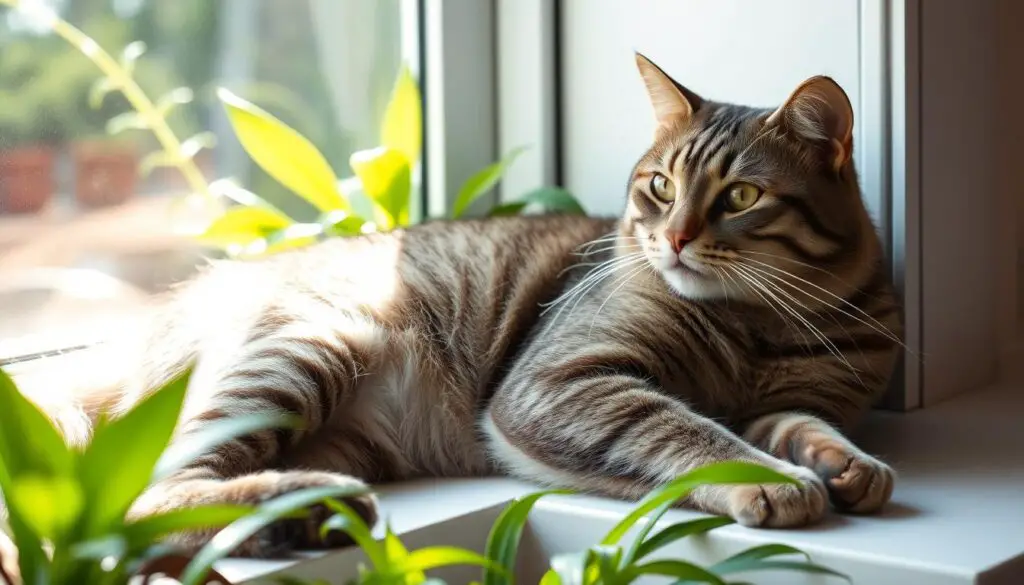
Figuring out when your cat is fully grown means watching for physical and behavioral signs. It’s helpful to measure and weigh your cat every month. This shows how they’re growing.
Physical Indicators
Your cat’s size can be seen in their weight and body shape. Most cats stop growing at about 12 months. By then, 95% of their growth is done.
Domestic shorthairs usually weigh 12 to 14 pounds. But bigger breeds like Maine Coons can weigh over 25 pounds. They may take up to three years to fully grow up.
Checking your cat’s weight each month helps you know when they stop growing. Kittens gain about one pound a month for the first five months. When their weight stops changing, it means they’ve stopped growing.
Behavioral Changes at Maturity
Behavioral changes also show when a cat is fully grown. Adult cats are calmer, less active, and have set social behaviors. By 18 months, most cats are fully grown and mature.
Growth Chart Overview
| Age | Average Weight | Growth Milestone |
|---|---|---|
| 0-6 Months | Up to 8 Pounds | Rapid Growth Phase |
| 6-12 Months | 12-14 Pounds | Approaching Adult Size |
| 12-18 Months | Varies by Breed | Behavioral Maturity |
| 18-24 Months | Up to 25 Pounds* | Full Size for Large Breeds |
*Maine Coon cats may reach up to 25 pounds.
Common Growth Concerns and Solutions
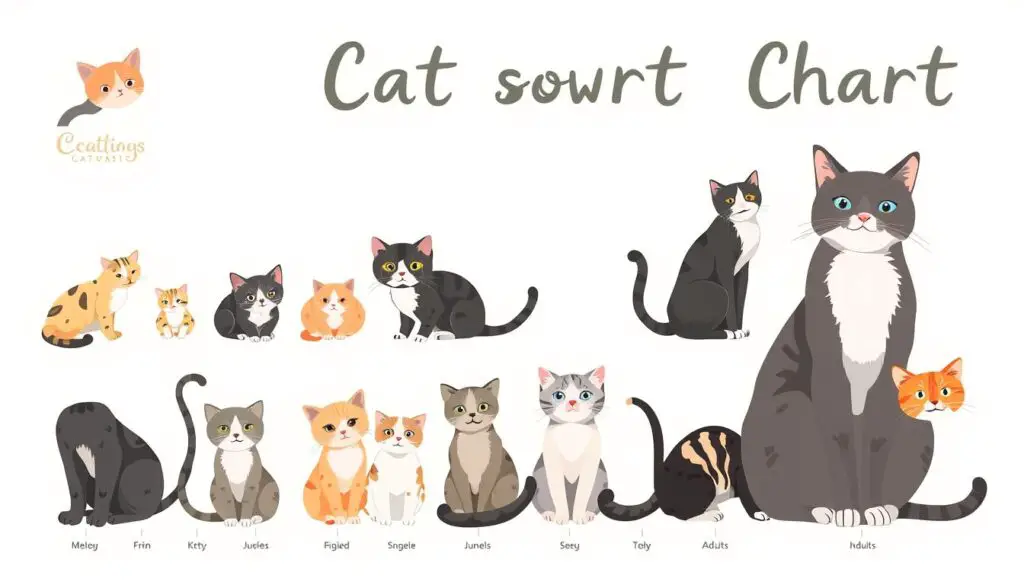
Caring for a growing cat means knowing about feline growth patterns. You also need to fix any problems that come up. Issues like dwarfism and bone deformities can stop a cat from growing right.
Spaying or neutering at the right time is crucial. Cats spayed or neutered early grow bigger than those done later. Using a cat growth chart helps keep an eye on your cat’s growth.
- Dwarfism: A genetic condition that makes a cat much smaller.
- Bone Deformities: Can mess with normal growth and movement.
- Early Spaying/Neutering: Helps with healthier growth and bigger size.
If your cat’s growth looks off, see a vet. Good food and timely medical care can fix many growth issues. Knowing when do cats stop growing helps plan their diet and health care.
Conclusion: Ensuring Healthy Growth Throughout Your Cat’s Life
Knowing your cat’s growth stages is key to giving them the best care. From being a tiny kitten to becoming a full-grown cat, each stage needs special attention. Kittens grow fast, reaching about 75% of their adult size by six months.
The growth timeline for cats varies by breed. Most cats stop growing between one and two years old. But bigger breeds like Maine Coons might grow until they are four years old. Keeping an eye on these stages helps keep your cat healthy and happy.
Good nutrition is vital for your cat’s growth. A balanced diet with all the necessary nutrients helps their body and mind grow. Regular vet visits help track your cat’s progress and solve any problems quickly.
Even when your cat gets big, they still need lots of love, affection, and snuggles. You can ensure a long, happy life together by being informed and caring for your cat’s needs at every stage.
FAQ
When do cats stop growing?
What are the different cat growth stages?
How does breed affect a cat’s growth rate?
What factors influence feline growth cessation?
What are the key indicators of proper cat growth?
How can I support my kitten’s growth through nutrition?
What are the physical indicators that my cat has reached full size?
Can spaying or neutering affect my cat’s growth?
What should I do if my cat shows signs of stunted growth?
How can I accurately track my cat’s growth?

Hello, this is Frank Swanson, the owner, and operator of Pet Info Hut. I created this website as a way to share my love of pets with the world. I have over 7 years of experience working with animals, and I have a passion for helping people care for their pets. I hope that you find my website useful and informative. Thanks for visiting!

